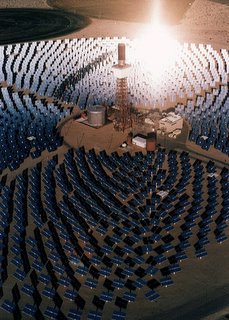ElectriPlast Technology Spin-Offs – Solar Power…

Niche
Markets
By PK
ElectriPlast Blog Publisher
[ElectriPlast Blog Publisher's Note: One of the reasons behind this Blog is to highlight opinions on some of the emerging spin-off prospects surrounding ElectriPlast, and to speculate on those future applications -- Here's to a Better Future, PK sends...]
Today, I wanted to take a moment to look at the potential of energy production. In this instance I am looking at solar power and how ElectriPlast can impact a market still under development.
First, a little Background -- What is ElectriPlast?
According to the Integral Technologies website [http://www.itkg.net/], ElectriPlast is a breakthrough technology. By using plastic and metal in a way no one dreamed possible, ElectriPlast combines the connectivity of metal with the lightness and malleability of plastic.
The conductive nature of this ElectriPlast material is estimated to be equal or better than that of copper, and due to the disruptive nature of the material and its proprietary recipe, it is reputed to be adept in its ability to distribute power—an effectiveness which can, and possibly one day will, be a perfect fit to the Solar Power industry.
Why Solar Power?
Before going into the whys which should be apparent, let me point out the differing solar applications currently on the books, and those considered as futuristic.
First there is single appliance and home solar cells.
These are the panels you may have seen on the side of the highway to power emergency phones, signs, or even on the rooftops of neighboring homes. In general these systems suck-in energy from the sun, in some instance this energy is used to heat/cool water offering energy savings to homeowners. In other instances, this energy is converted directly to electricity, and is used to charge rechargeable batteries, or in some instances, used in feeding power back to the electrical power-grid.
Second, there are mass solar farms.
These are used the same ways as the smaller systems, but the primary goal is to feed the energy back directly into the electrical power-grid.
The futuristic proposals mentioned earlier range from the notion of solar farms covering desert wasteland--to the idea of giant satellite-borne solar collectors.
Though, at present, there may be numerous problems with the latter proposal, the general idea is to have these systems feed into a power-grid, greatly reducing, or in some cases eliminating whole nations dependence on alternative means of electrical energy production. And therein lies the answer to why advocates consider Solar Power an essential niche solution to resolving our worlds ever-present thirst for energy.
Where does ElectriPlast fit into this mix?
As yet, it doesn’t, or if it does, the details are hidden within provisional/pending patent applications. The reality though is that the notion of Plastic Solar Cells being a cheaper source of material over that of conventional solar cell materials is nothing new. Integral Technologies, the company that holds the IP rights to their own plastic-based leading edge material enhances their potential move toward this new twist on an old and potentially profitable medium for energy producton. They hold a growing number of issued patent rights on the basic ElectriPlast formula/technology; they have filed well over 40 provisional patent applications on issues surrounding their ElectriPlast technology; and they have an expanding number of pending patent applications that further broaden the prospective uses of ElectriPlast [Integral's Patent Page].
Though the company has not yet pointedly come out and identified their focus in this area—considering how aggressive they are in regards to the protection of their IP via patent applications—it would be unwise to think that the prospect had not yet crossed their radar.
[ElectriPlast Blog Publisher's Note: In looking further into Solar Cells technology spin-off prospects & profitability, I uncovered the following news releases.]
The first from Georgia Tech entitled “Tech Developing Efficient Organic Solar Cell” gator tech -- news
This article notes: "As the price of energy continues to rise, businesses are looking to renewable energy for cheaper sources of power. Making electricity from the most plentiful of these sources - the sun -can be expensive due to the high price of producing traditional silicon-based solar cells. Enter organic solar cells. Made from cheaper materials, their flexibility and feather-weight construction promise to open up new markets for solar energy, potentially powering everything from Radio-Frequency Identification (RFID) tags to iPods and laptop computers"…
…According to Bernard Kippelen, professor in the Center for Organic Photonics and Electronics and the School of Electrical and Computer Engineering at Georgia Tech [Technical Contact: Bernard Kippelen, 404-385-5163, bernard.kippelen@ece.gatech.edu] “Once fully developed, organic solar cells could revolutionize the power industry. Their flexibility and minimal weight will allow them to be placed on almost anything from tents that would provide power to those inside, to clothing that would power personal electronic devices. The solar cells are still at least five years away from residential applications, said Kippelen. But he estimates that they’ll be ready to use in smaller devices, such as RFID tags, used by some retailers to control inventory, within two years. Kippelen and other professors at the Center for Organic Photonics and Electronics started LumoFlex, a spin-off company based at Georgia Tech, to capitalize on the commercial applications of the research.”
The second news release comes from MSNBC entitled “Is the Price of Power Getting You Down?” msnbc -- news
This article digs into the new “nanotech” innovations with Solar Cell technology.
The third news release comes from Renewable Energy Access entitled “WorldWater & Power’s Quantum Energy Completes 400kw California Solar Project.” renewable energy access.com -- news
This article discusses how a company uses California’s new $3.2 billion and incentives program and the local energy company’s work-with energy feed-back relationship to virtually pay for the utility consumption of four tenant occupied buildings.
The final release comes from MyWestTexas.com, and follows up on the story focusing on “California Legislators Approve $3 billion in customer rebates to promote use of solar power.” mywesttexas.com -- news








0 Comments:
Post a Comment
<< Home